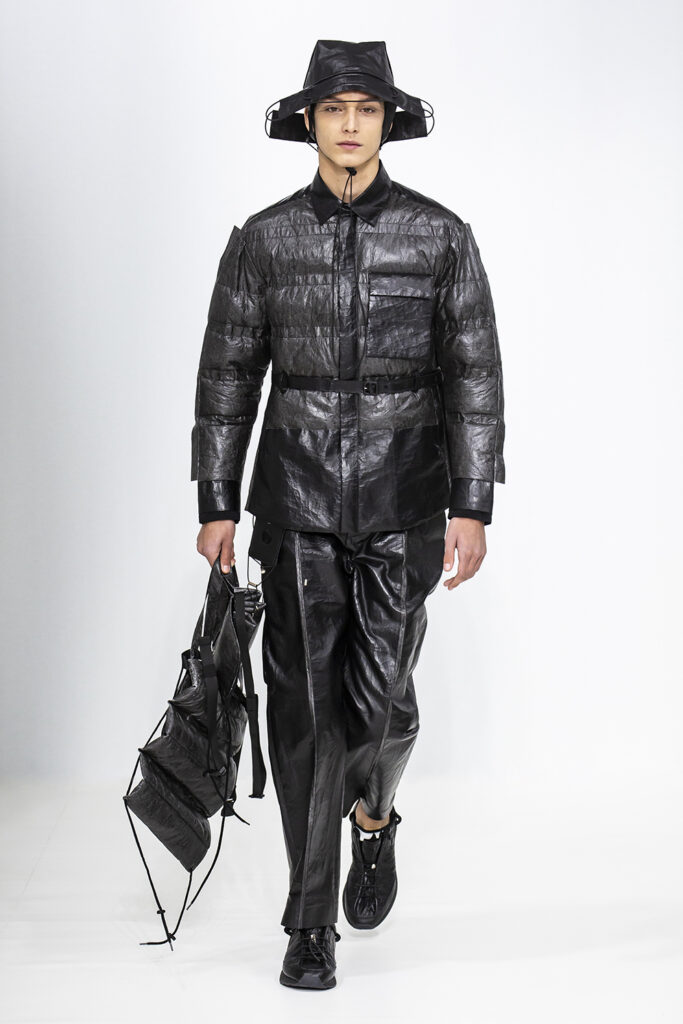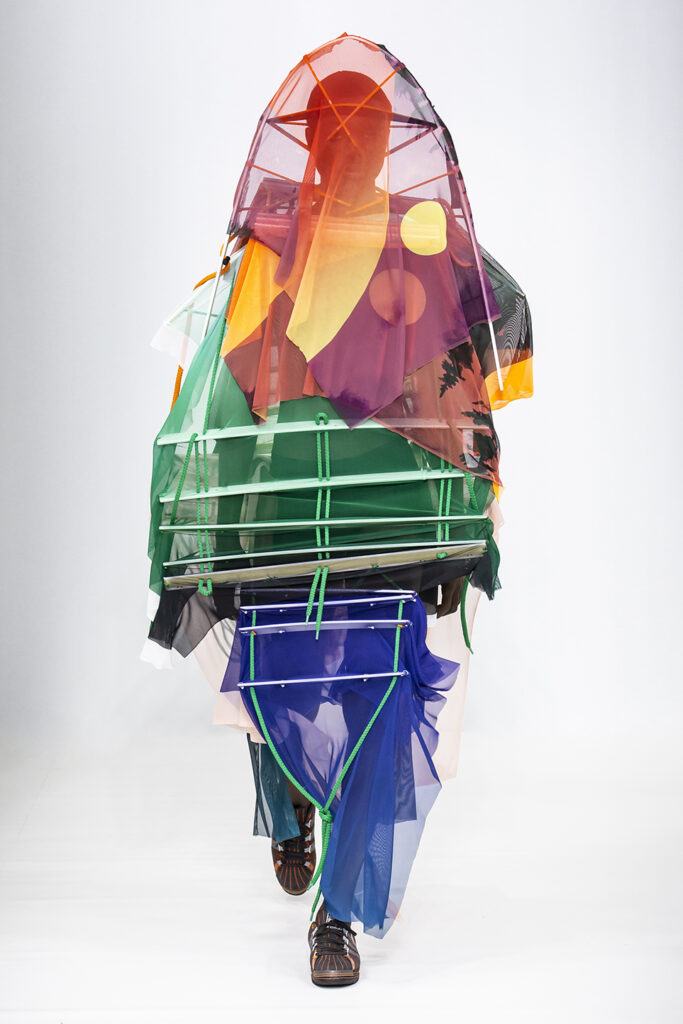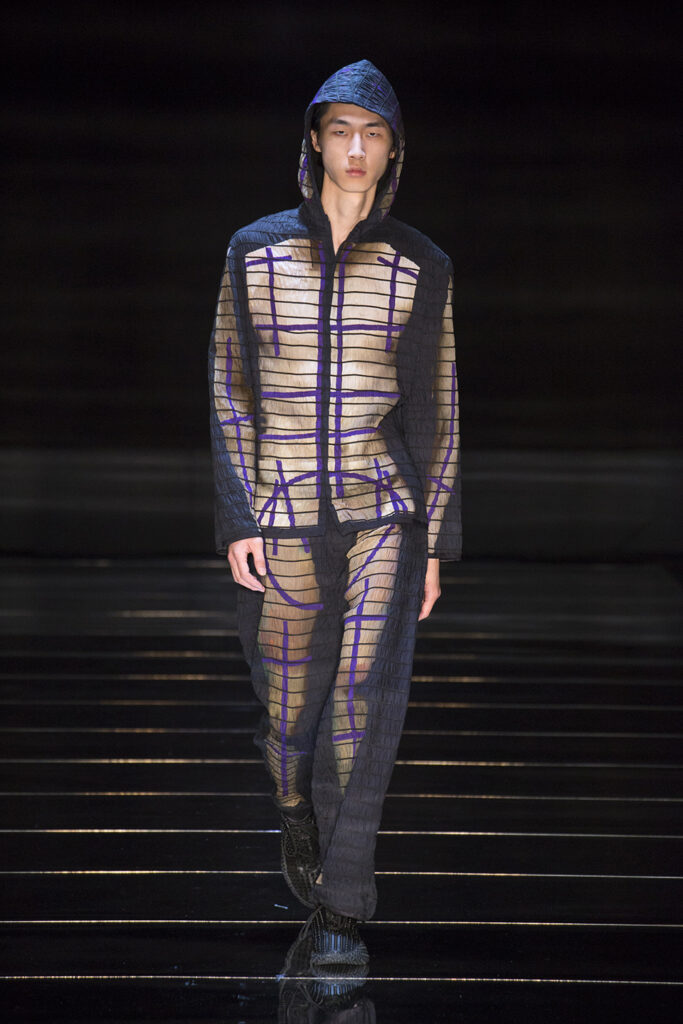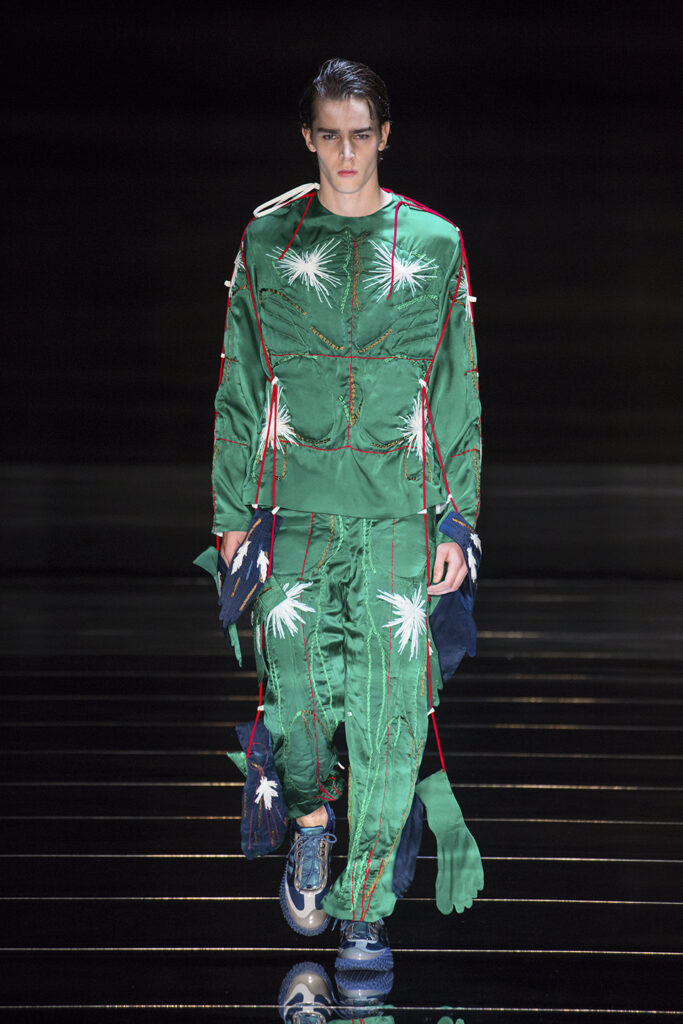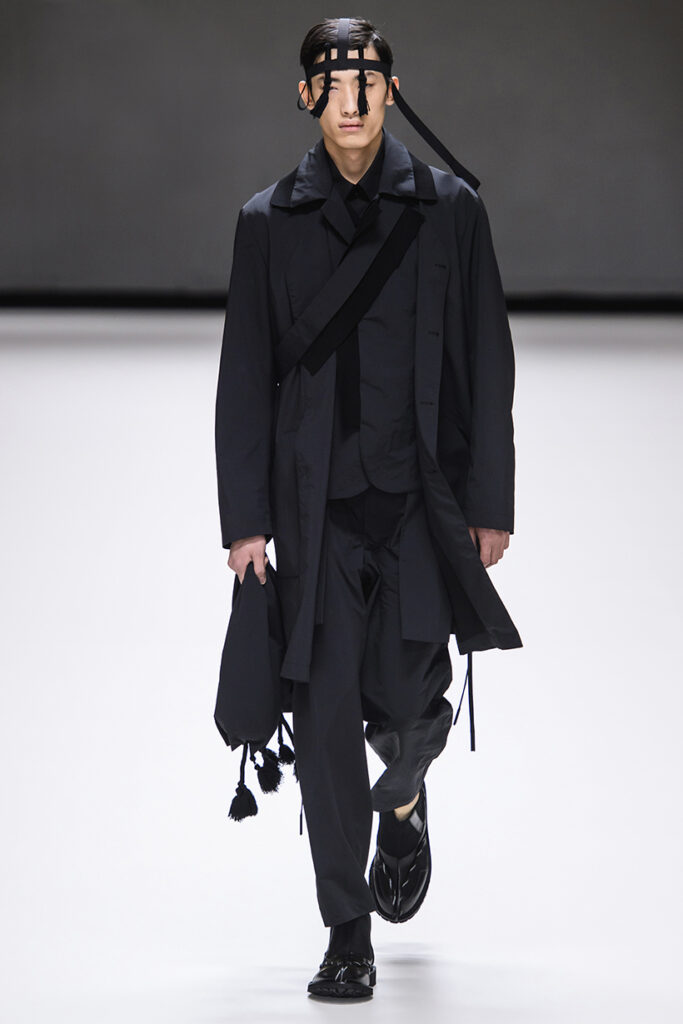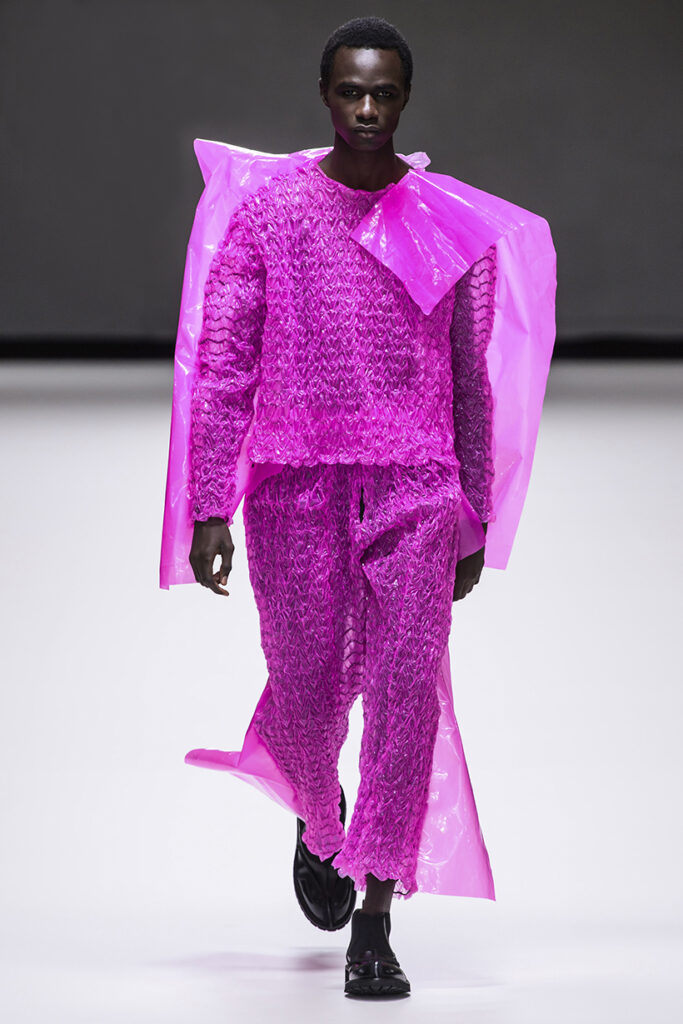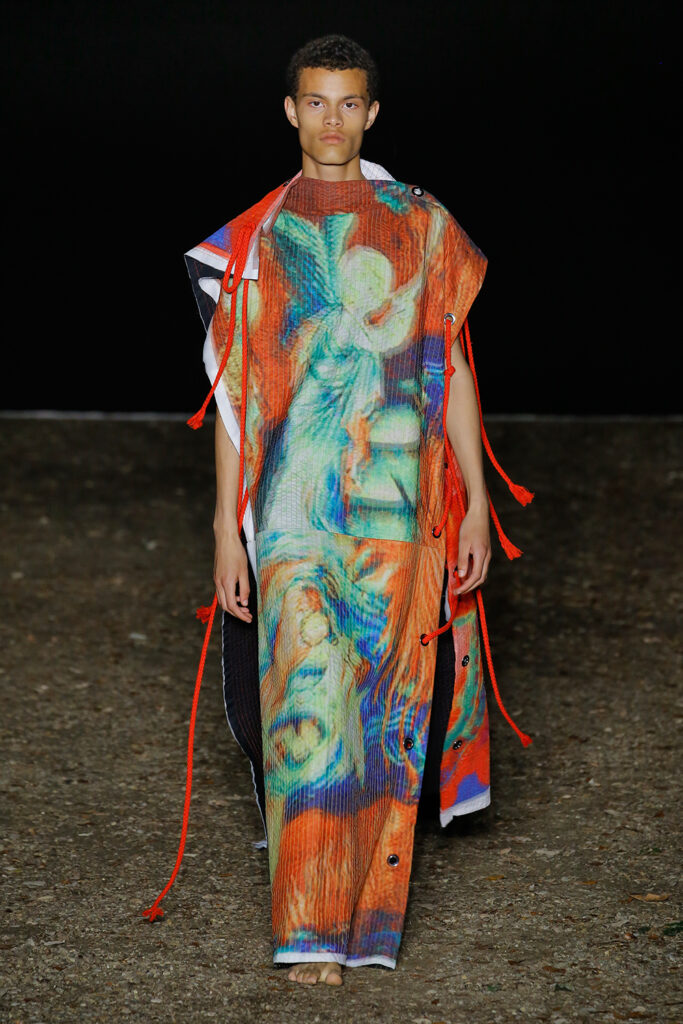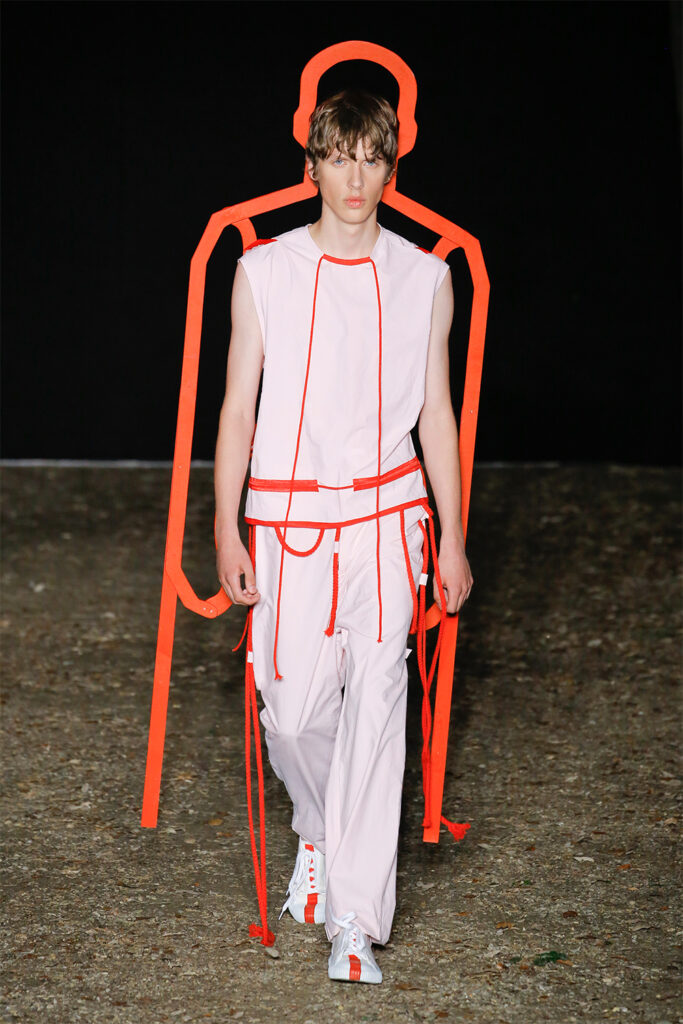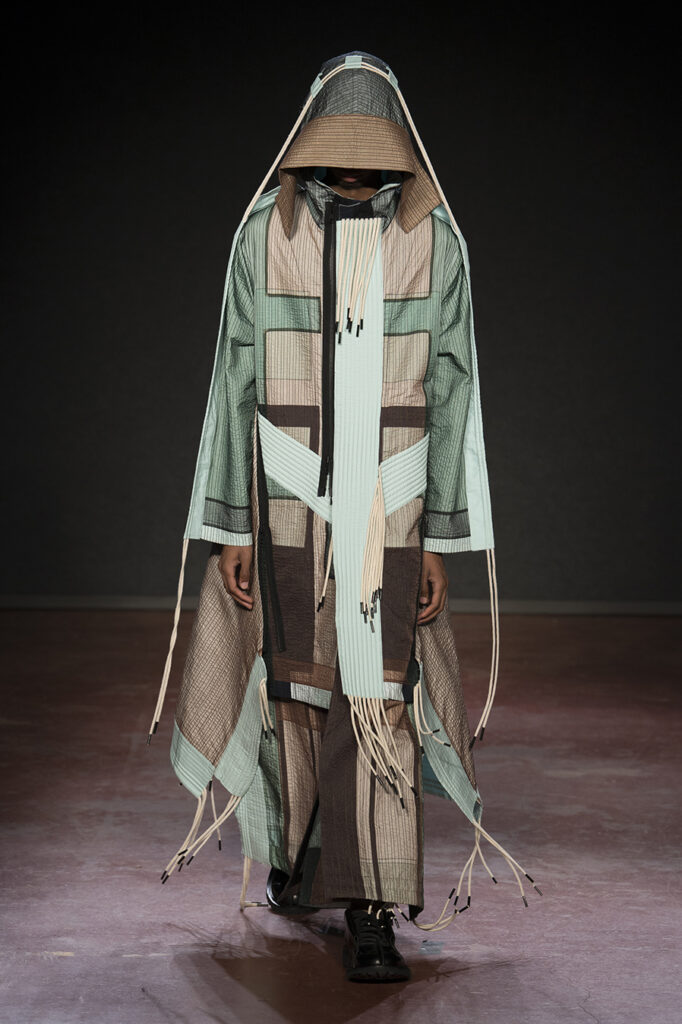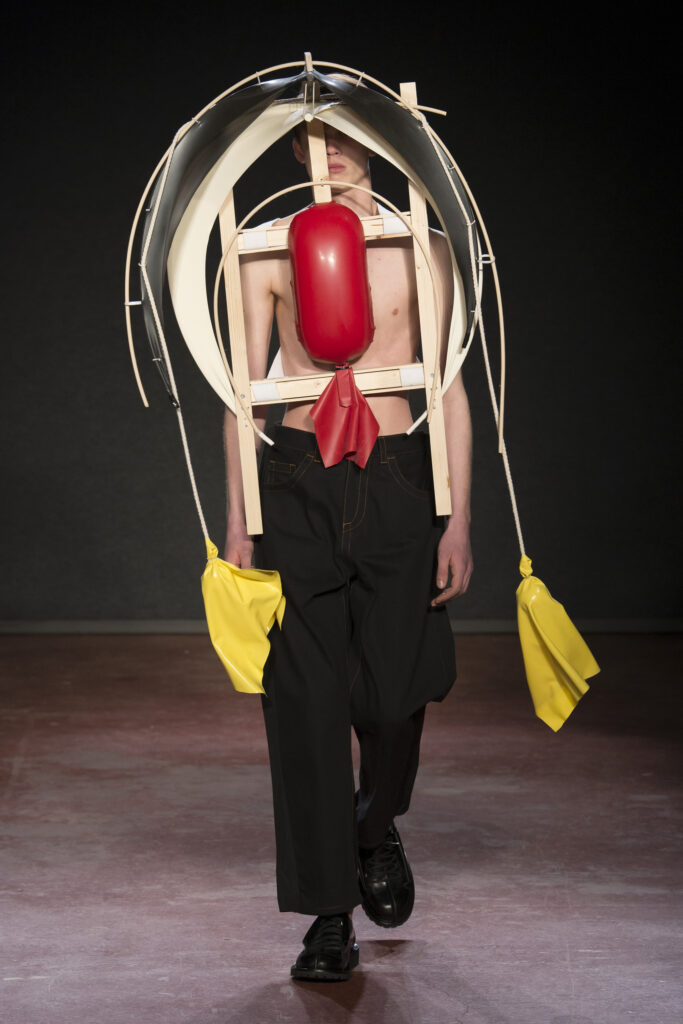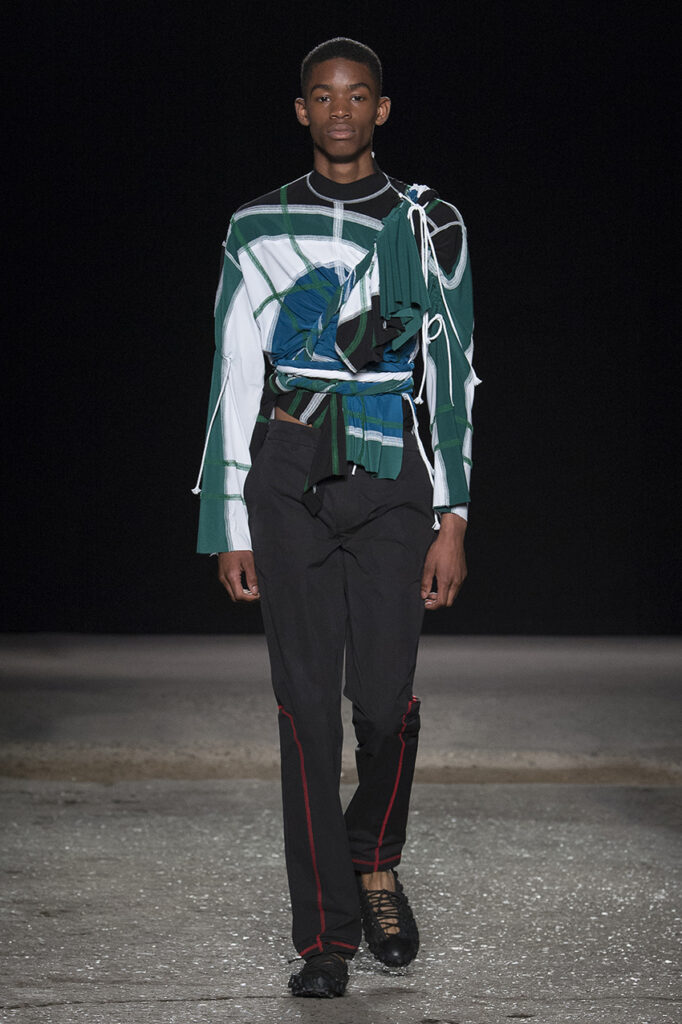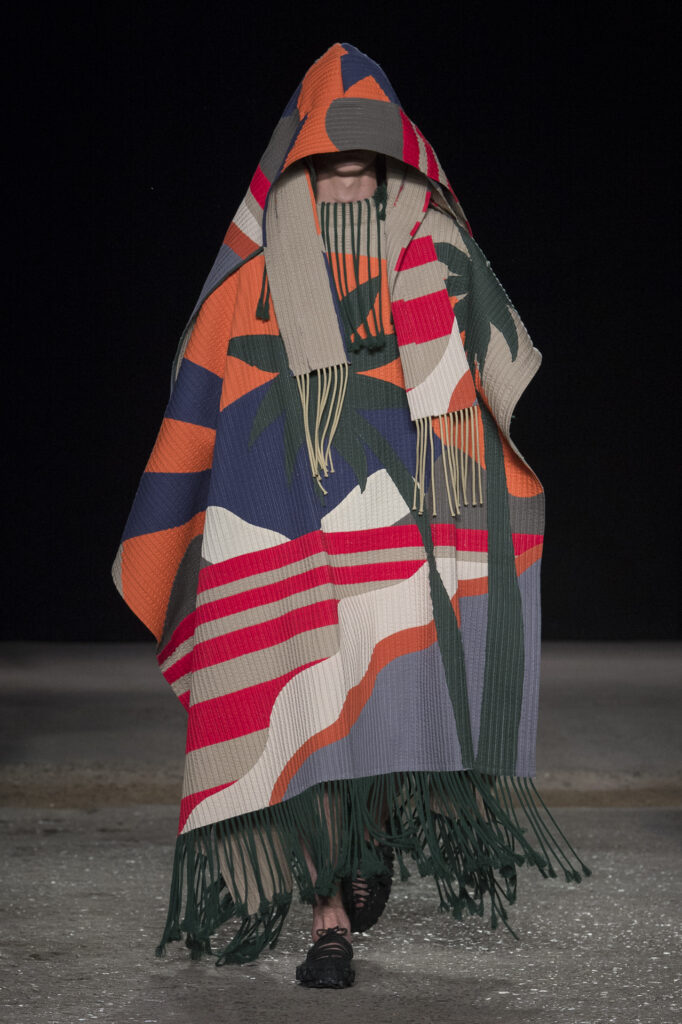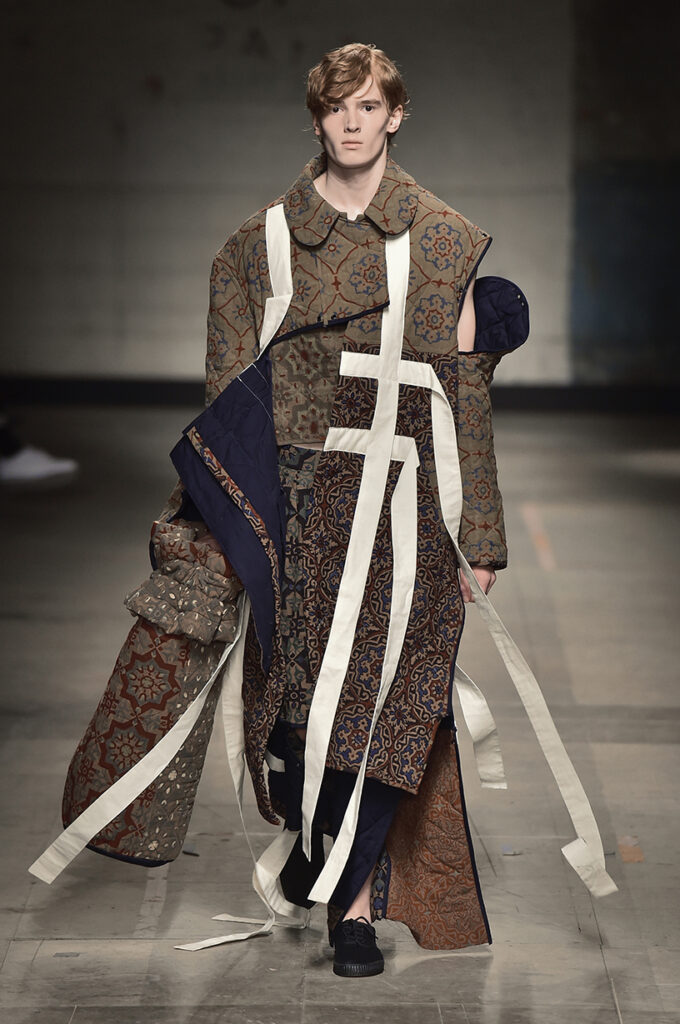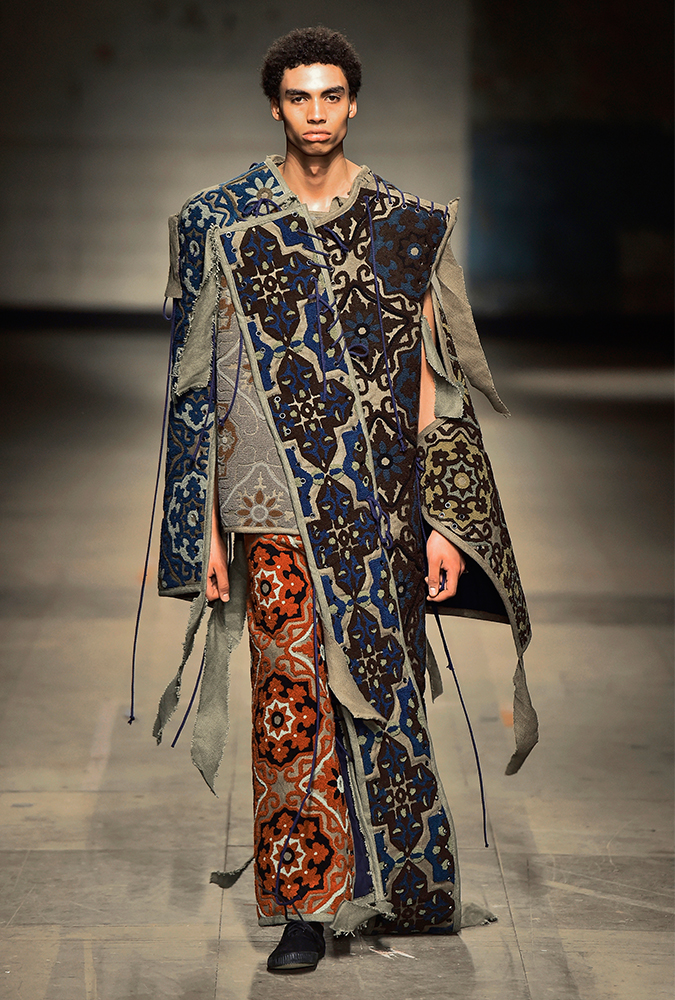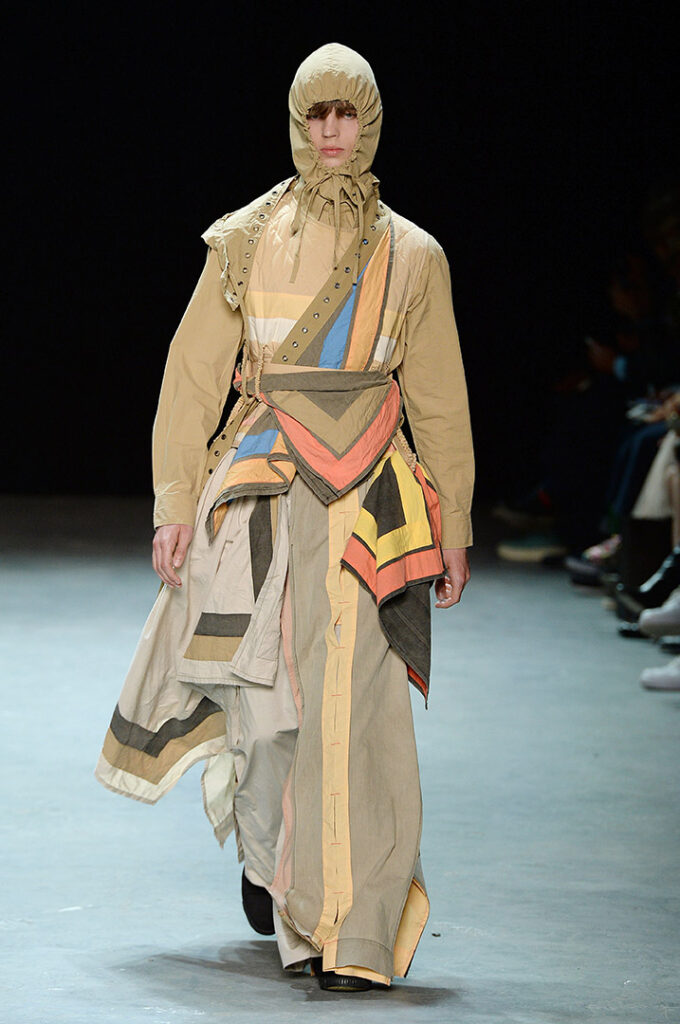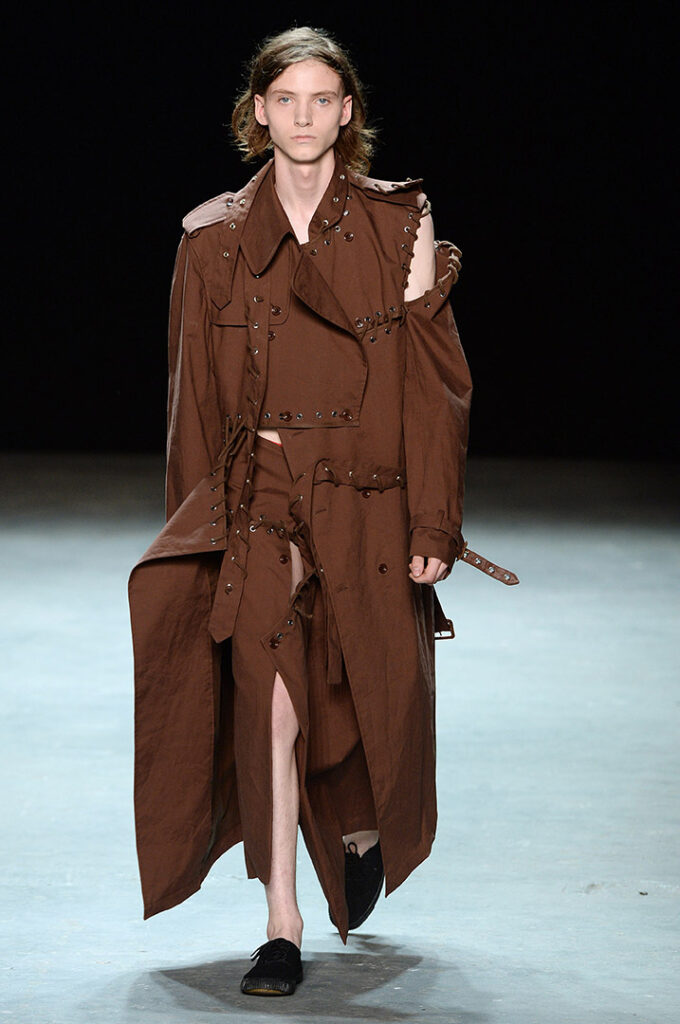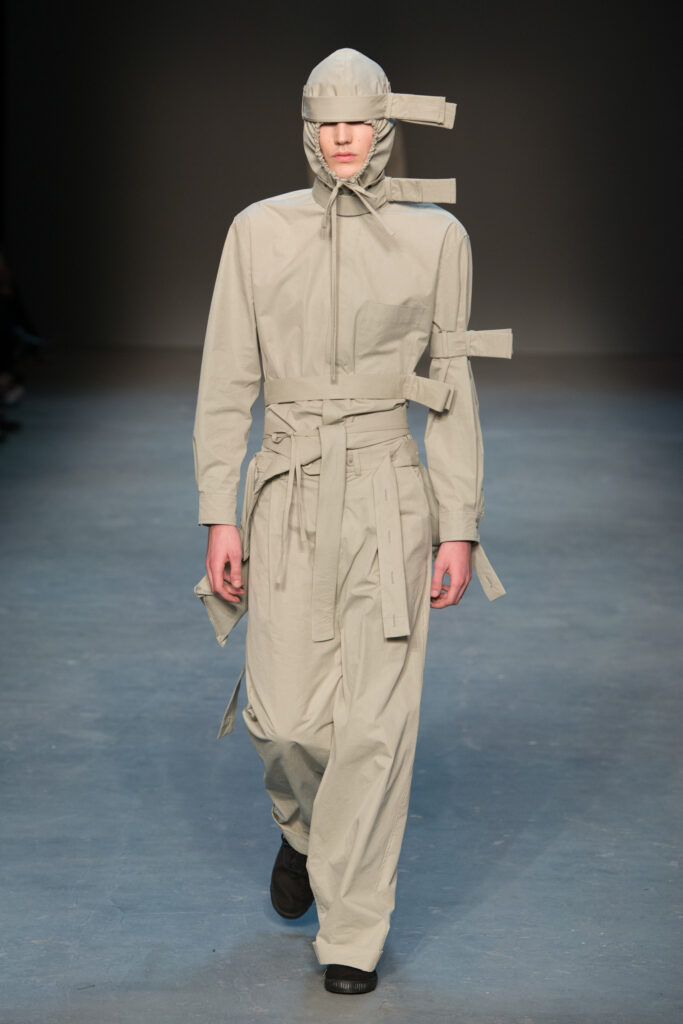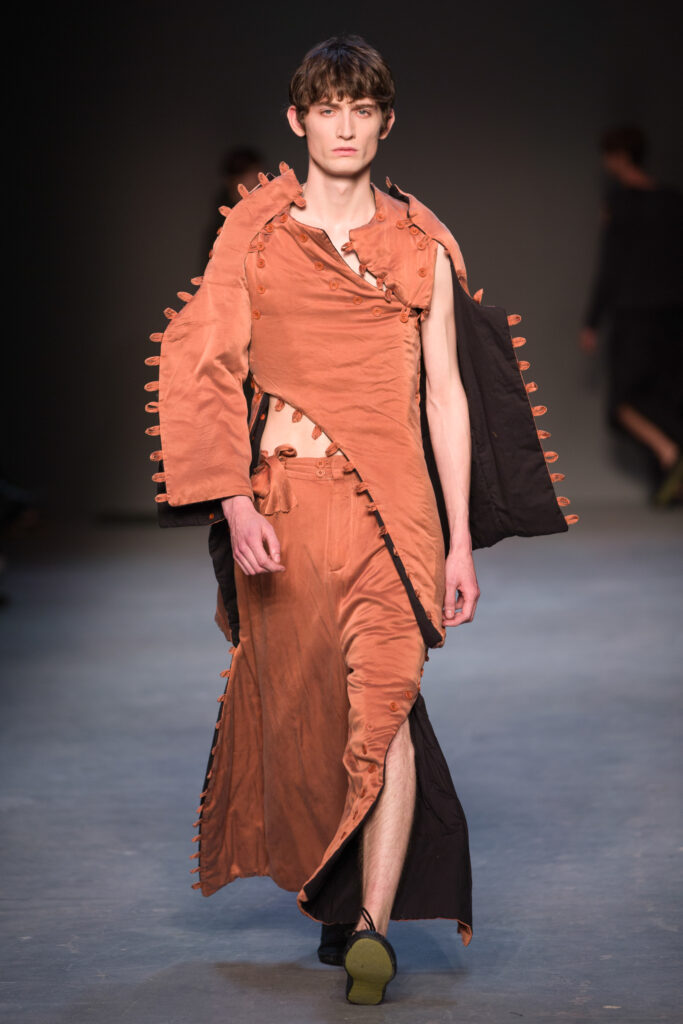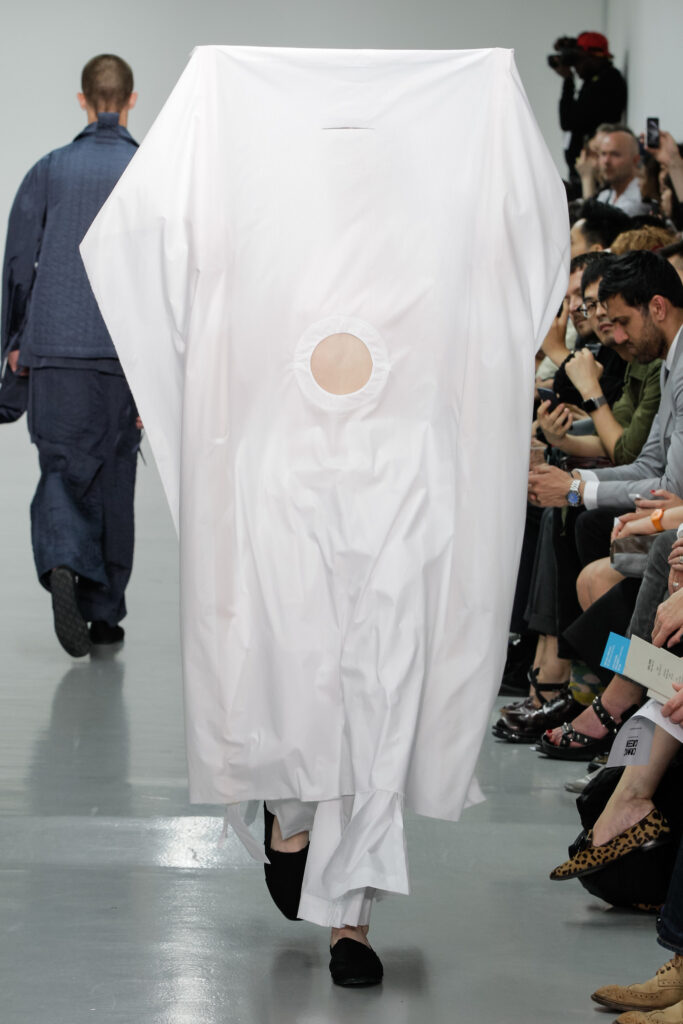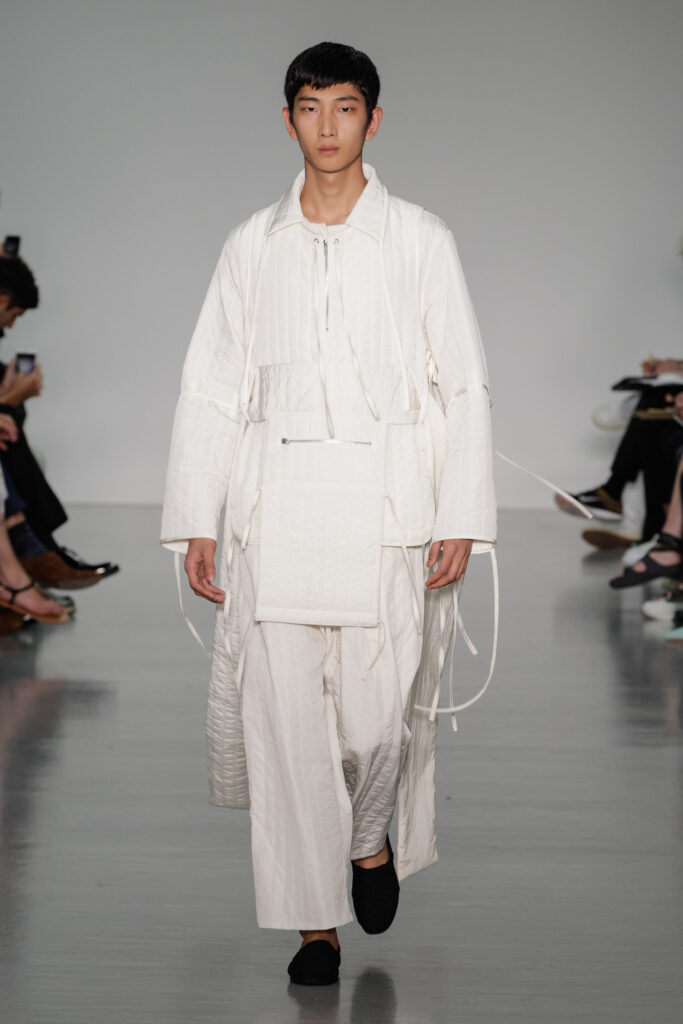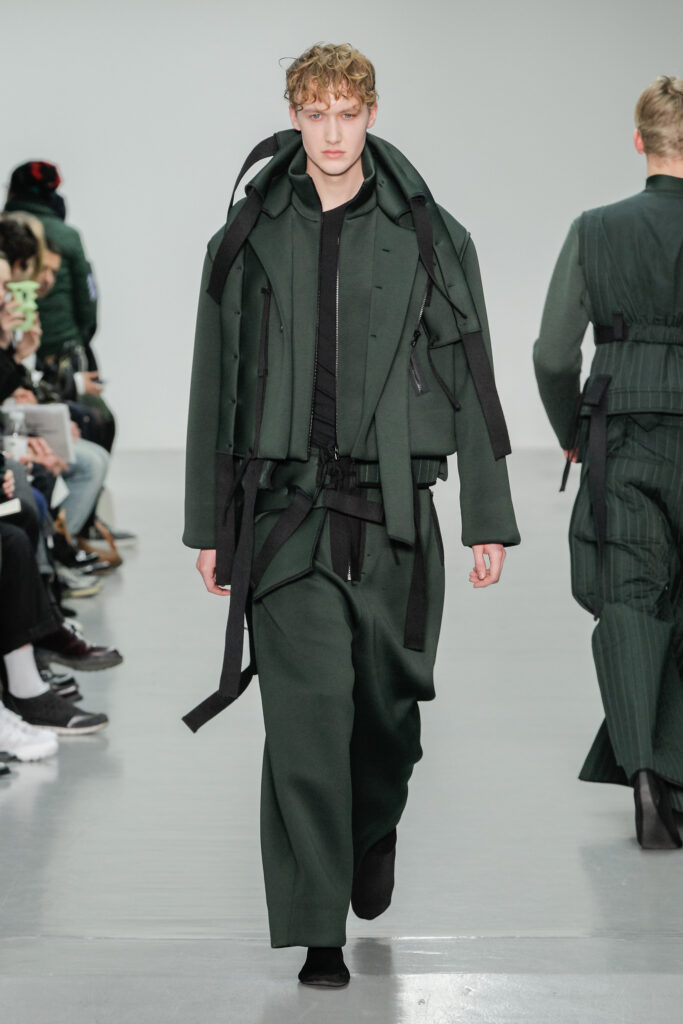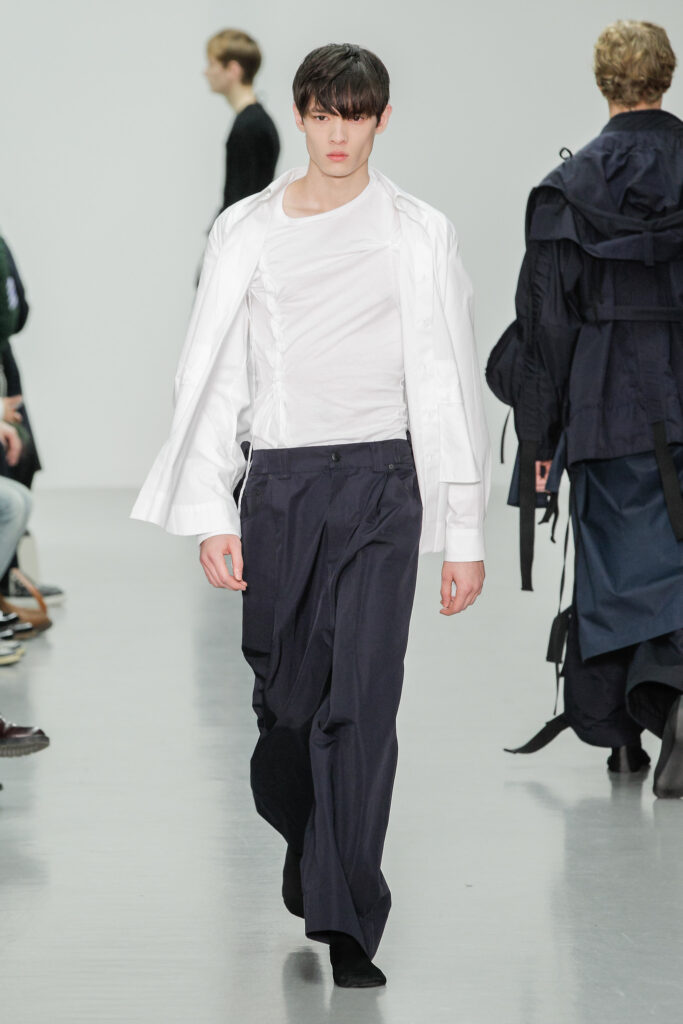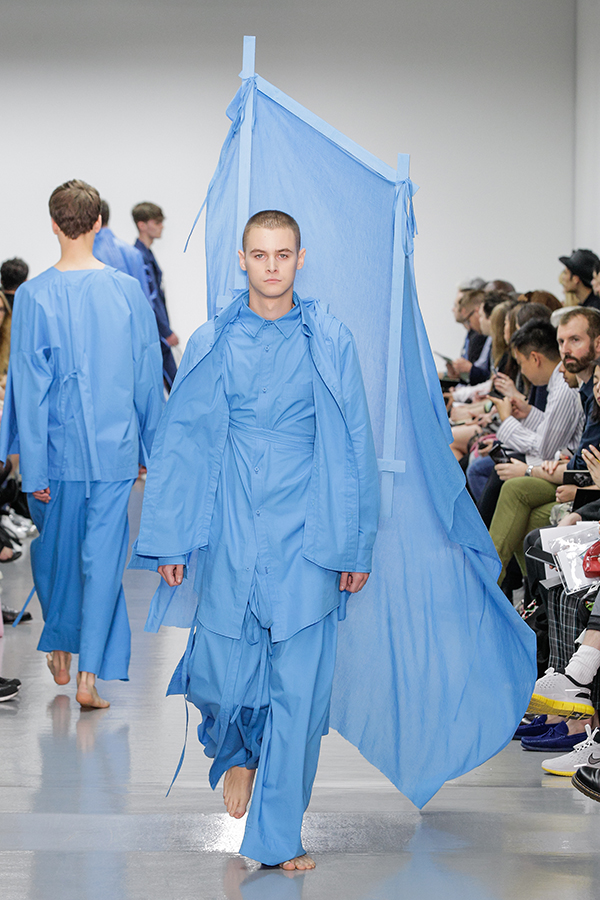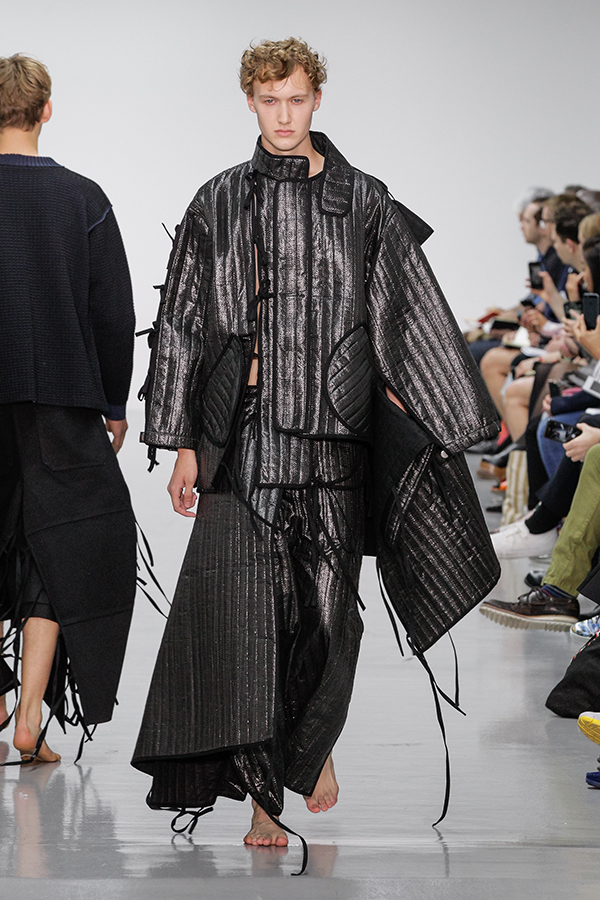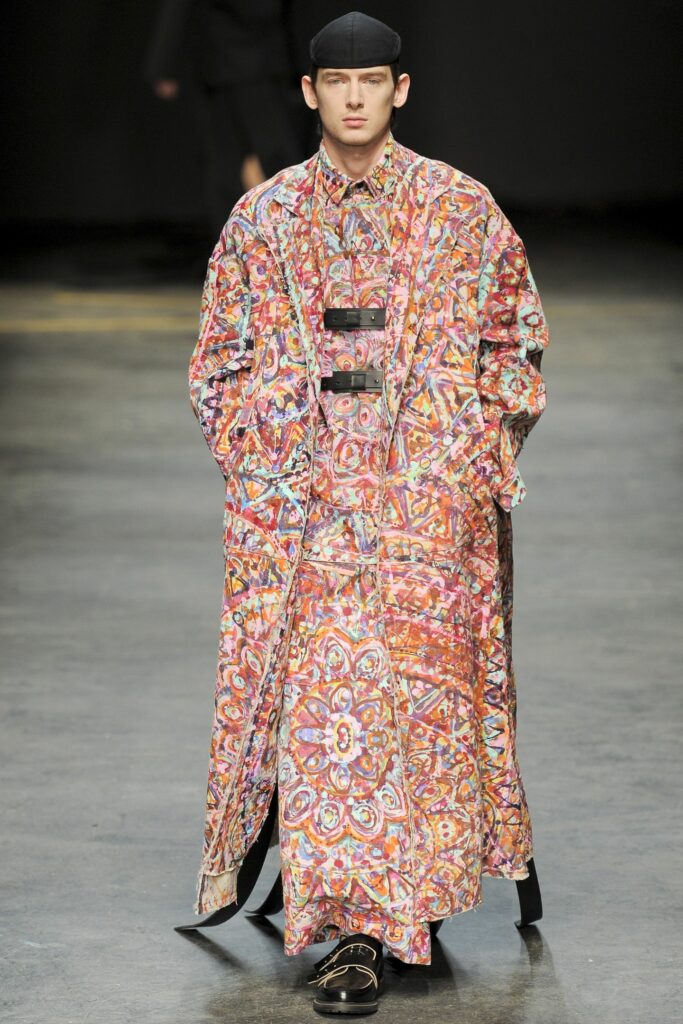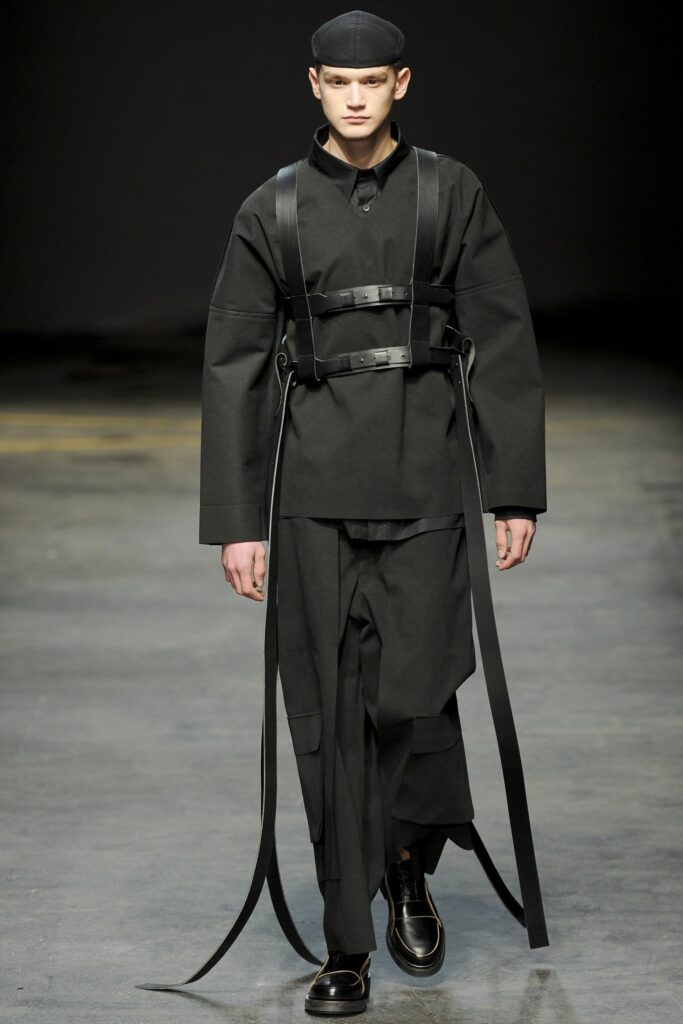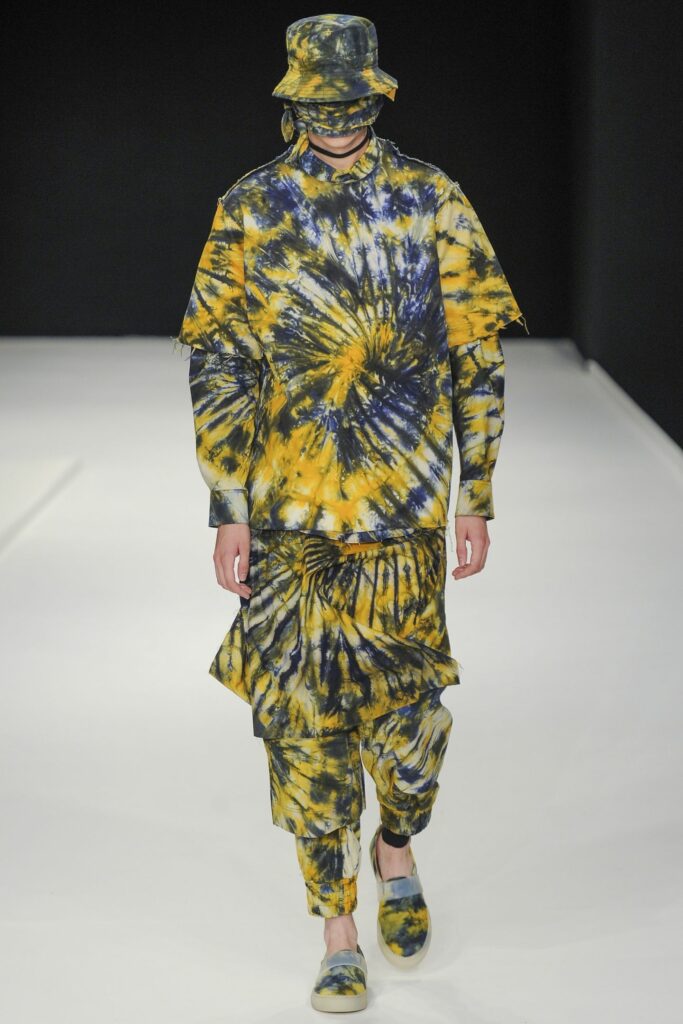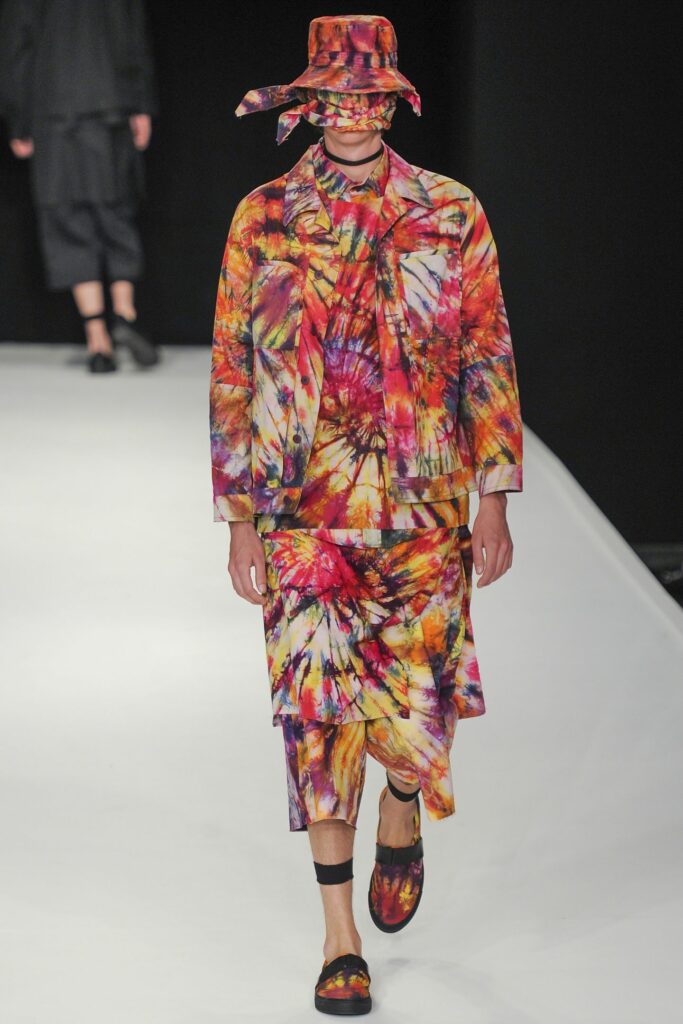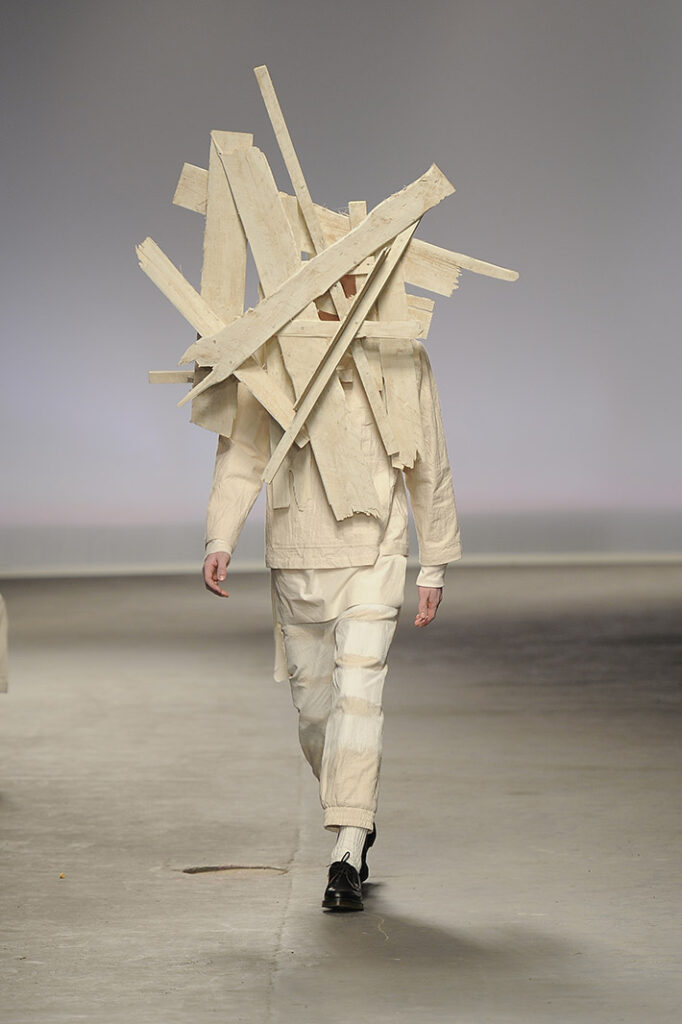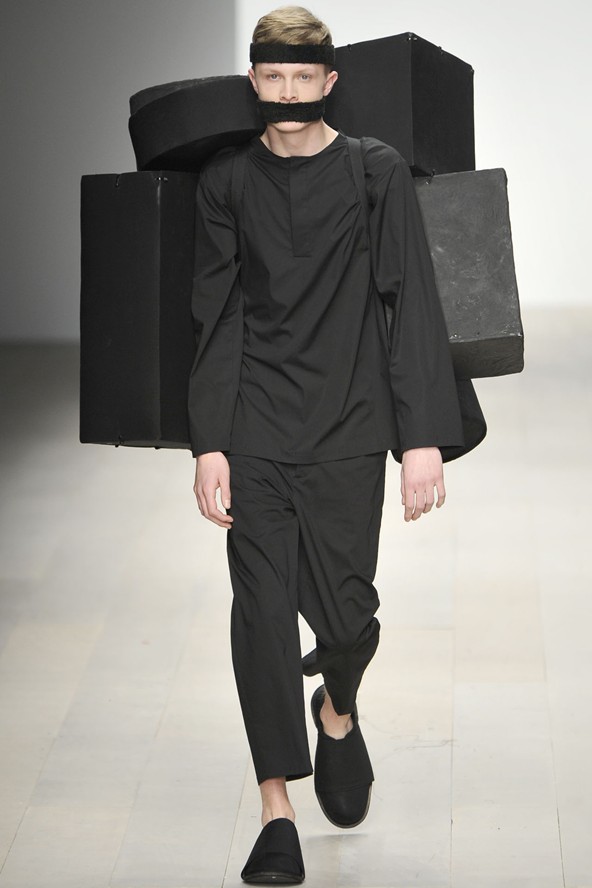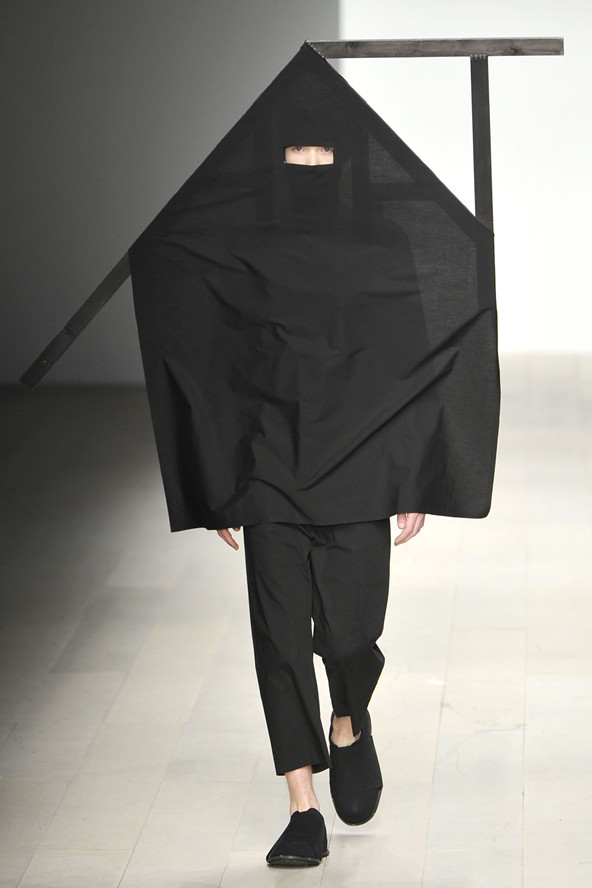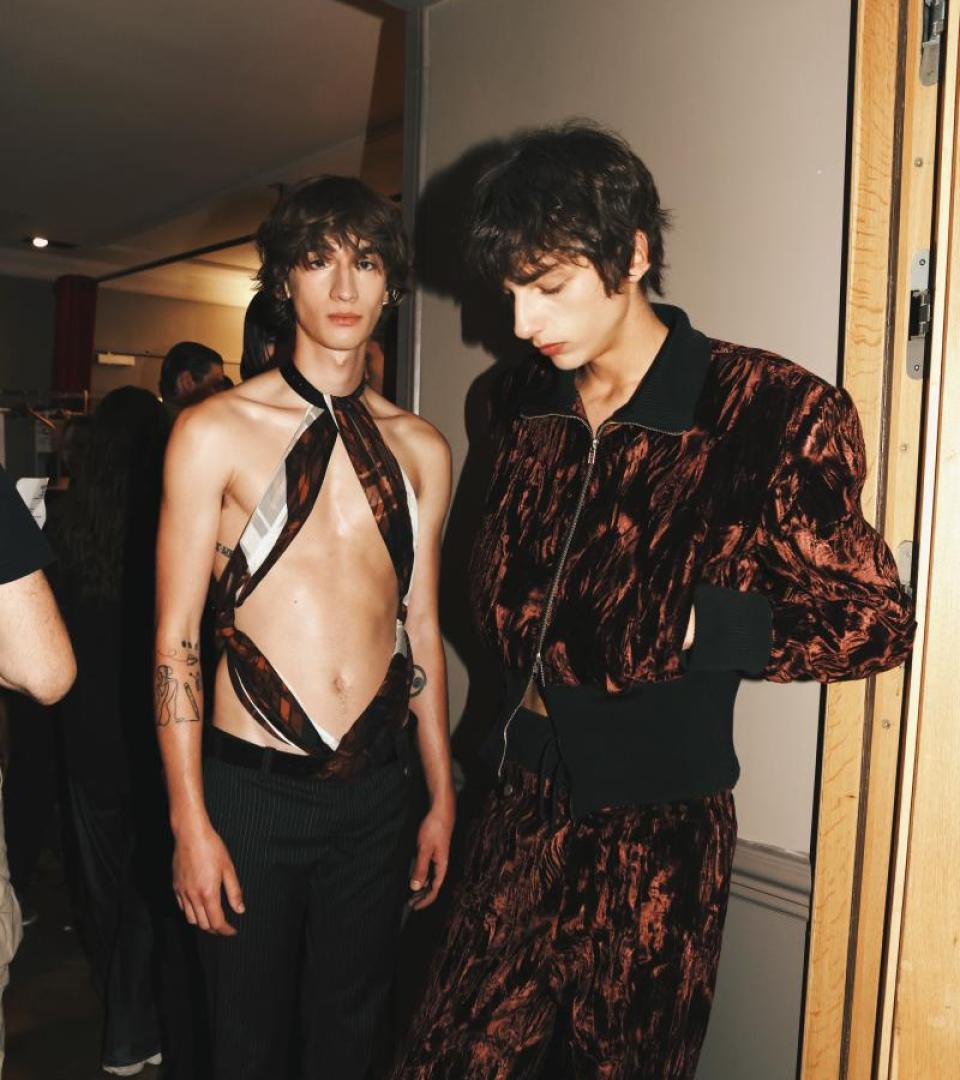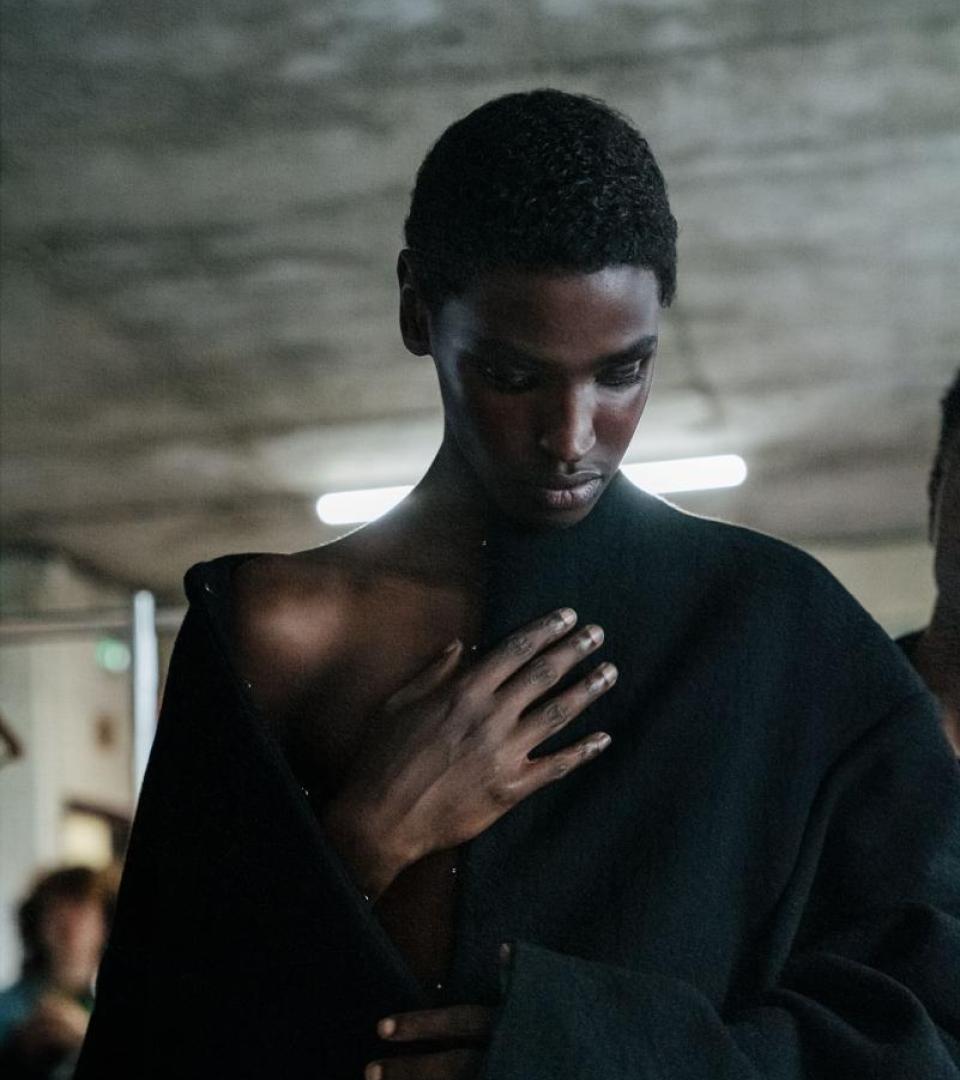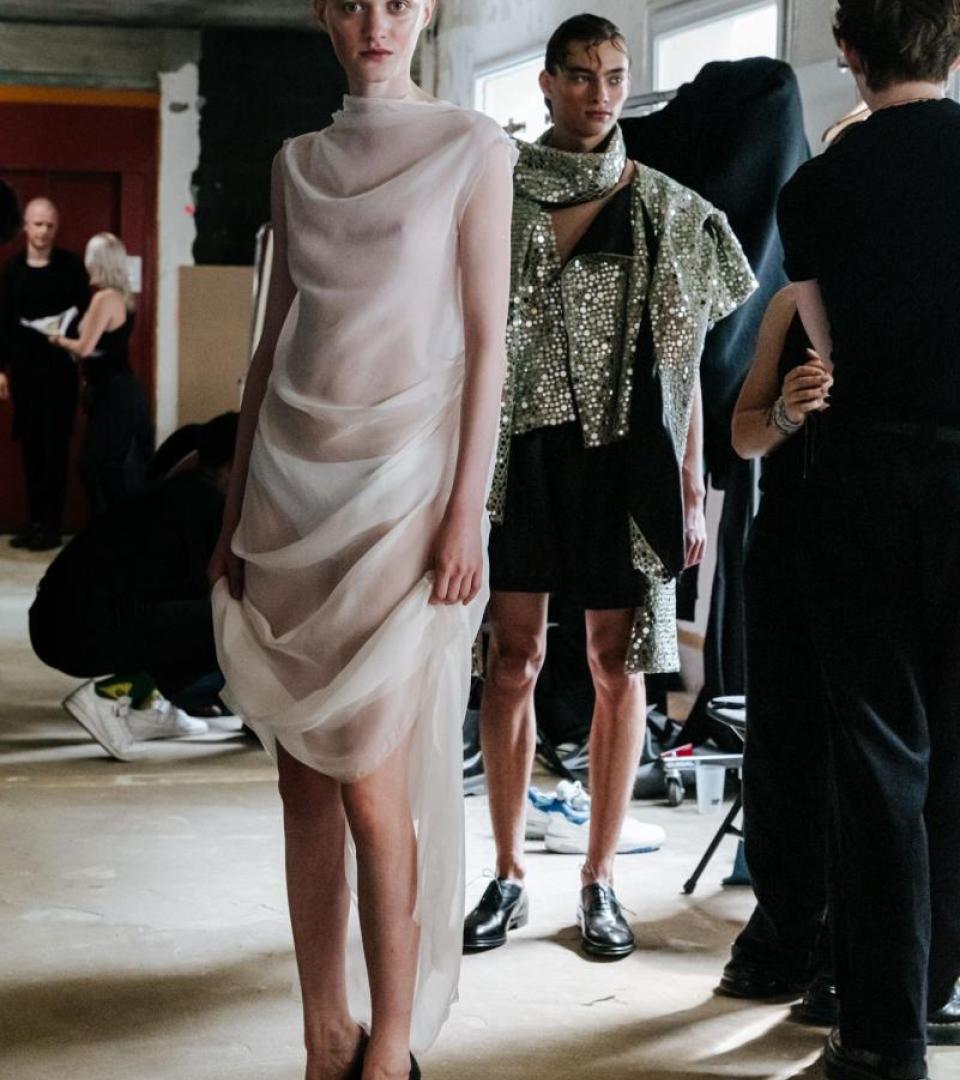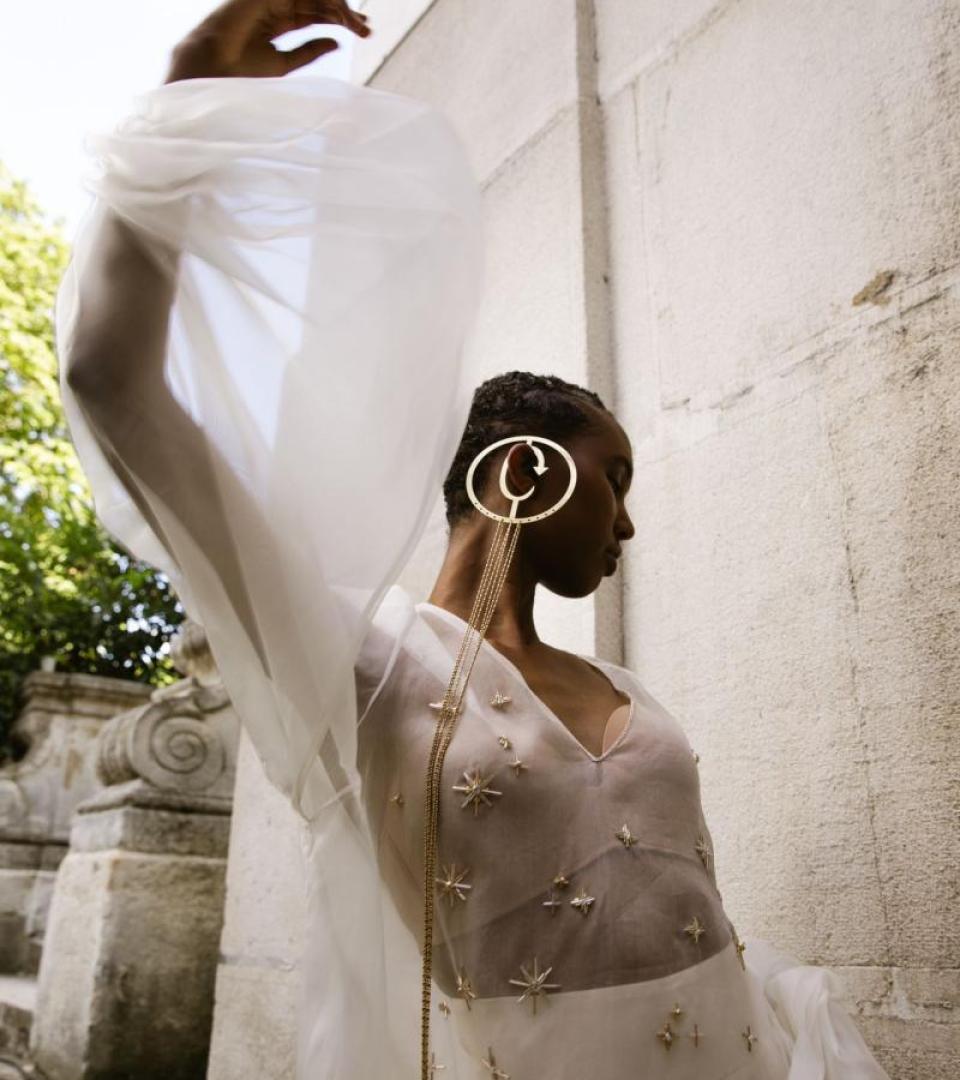Craig Green and Tim Blanks interview
I was at Craig Green’s graduate show, which is why it was one of the first things I wanted to ask him about. When you see a young designer who is so utterly different, so absolutely convincing in his defiance of whatever else is going on, you can retreat into confusion or you can choose to see the future. Or both. Eight years later, I’m glad I chose to see the future. That’s what he is. Light vs. dark, spirit vs. flesh, hope vs. despair: you can trace every fundamental opposition through his work. But at the end of all that, Craig’s clothes ultimately make me happy, because he’s fashion’s great humanist. And if I was going to be dramatically reductive, I would say fashion needs him.
TB: How often do you see a student show when you’re thinking ‘Wow, that point of view isn’t coming out of anything that’s happening at the moment’? It was such a stark departure from anything else that anyone had seen. What was driving you at that point?
CG: I think the reason why I continued further education was because I met Louise Wilson. When I was on the BA print course at Saint Martins, I wasn’t really an outcast, but I definitely didn’t fully fit in. McQueen was really a thing at that time so everyone was doing dark, feminine florals and illustrative prints. I was more about printing a big black block on a piece of fabric. Going even further back, I wasn’t sure if I was going to do women’s or men’s and then I discovered Walter Van Beirendonck and he showed me that fashion could be from anywhere and be about anything. So then I shifted into making it about where I come from and what I know. Which is why I didn’t really fit in with the print course. And then I met Louise Wilson and she offered me a place on the MA at Saint Martins.
TB: What do you think she saw in you at that point?
CG: I wasn’t sure. My BA collection was lots of kind of wooden meat sticks, like kebab skewers, that were handsewn into fringes and very heavy, wooden bird house things and balloons. And then my MA had this big black house, so it wasn’t too far away from what the BA was. I always got along with Louise. I think she understood where I wanted to go. Even if I didn’t understand myself where I fitted in or what I wanted to do, I think she understood where I could take it. She encouraged me to be like, ‘It’s OK to not fit in. Why do you want to fit in? Why do you care what they think?’
TB: What was your path to Saint Martins?
CG: I grew up in North London and I didn’t come from a creative family. I was the first person on both sides, including all cousins, to ever go to university. They all thought it was mad that I wanted to go and study art. When I said I was going to do fashion especially they said, ‘How many fashion designers does the world need really? Why don’t you do something useful? At least if you study architecture you can become a surveyor’. Very practical thinking. What job are you going to do? How are you going to buy a house? What money are you going to earn?
TB: If you came from an environment that wasn’t necessarily nurturing of those ideas in yourself, what did you see that made you think ‘this is what I want to do’?
CG: It was more my wider family that wasn’t encouraging. My mum and dad would always say, ‘Just make sure you’re happy. Be the best at what you do. No matter what you do – make sure you enjoy it’. That kind of thinking. And they did have an influence on me because my dad was a plumber, my other uncle was a carpenter, and my godfather is an upholsterer. I would earn money when I was at school in the evenings and weekends stripping sofas and helping him upholster things. So I was always surrounded by people that made things. My mum was a Scouts and Guides leader so she was always doing arts and crafts. So there was always that in my house; immersion boilers in the garden, materials everywhere, lots of kids, lots of people. So that had an influence on me, although I didn’t realise it until later on.
I think it was at school my interest began. It wasn’t just art but it was also graphics, industrial design, all of those subjects. I had energy when I was working on them and I think that’s how I decided the path. If I had to sit down and write an essay I wouldn’t have an inner drive where I could stay up all night. But if I was doing an art project, I wouldn’t stop thinking about it and I’d want to stay up all night and I’d want to cancel things to do it. That told me it was the path for me. It wasn’t like I was dreaming about a specific path within an industry, it wasn’t like I knew I wanted to be a fashion designer and I dreamed about it and knew everything about fashion, and the same for art as well. I just knew I liked to make things, I knew I was good at it and I had an energy to do it. I had a drive. I could stay up all night working on it, I could work all weekend on it because I loved working on it and I wanted more.
TB: Isn’t it interesting that there’s such a strong functionality about what you do? When you talk about immersion boilers in the backyard, there’s a sort of industrial element in what you do. The child really is father to the man.
CG: I remember a GCSE art project where I made a leg out of all my dad’s old plumbing pipes and things that were around the house. I made it with my godfather and he wasn’t a craftsperson or a builder, he was a very smart guy who didn’t really have a specific job. He used to be involved in Medieval re-enactments and he used to make me snow globes where he’d make the scenes inside. He was a family character. I made a few prosthetic limbs with him in his garage.
TB: There’s a Medievalism as well in what you do.
CG: Yeah, it’s weird. I didn’t realise it at the time, I only realise it when I look back where those influences come in.
TB: When you see something that is so unique and so untouched by anything else that’s going on, you wonder where that originality flourishes. It’s so interesting to hear that it really is rooted in your family background.
CG: I am very close to my family. I couldn’t have wished for a better upbringing. Although it can be frustrating when you’re a teenager and the house is full with ten children every night and the garden’s full of animals. You’re frustrated when you’re a teenager and you want your own space. But looking back I wouldn’t have wanted it any other way. From my mum and dad it was always support, it was never questioning what I wanted to do or where I would end up.
TB: So let’s get back to Louise’s MA course…
CG: As soon as I started the MA, I had a different energy. I got along with Louise well and respected her greatly. I realise I’ve always done best when I’ve had an educator who I really respect. My A-Level art teacher Mr Barby was the same. He passed away only a year after I left school so we never got to reconnect again, but he really inspired me and pushed me. I didn’t know what Saint Martins even was, I’d never even heard of it. It was Mr Barby who taught me about it. The same with Louise, she just always encouraged me to go further rather than to pull back. I remember once she went mad at me because me and my stepdad had made all those wooden houses, but we made them as prototypes so we’d stapled them all together and they were a bit rickety and a bit shit. When I brought them into her office she was like ‘I love them, they’re amazing’. Then for the show we remade them, but perfect. We had filled in all the gaps, sanded the wood, you couldn’t see any of the screws and she went mad – ‘what have you done? You’ve made them into some kind of IKEA disaster. Where are the good ones gone?’ So I had to go home and put the originals back together from the parts still in the bin.
TB: Tell me what that graduate show was, because it really laid the foundation in such a huge way for everything that’s happened since. What were you saying with that collection?
CG: There were a few different aspects in that collection, if you look back, you can see them appearing over and over again. There was definitely a minimalism, which I think is like a uniform. So there’s always that monochromatic feeling. But then there’s also something very complicated as well. Usually it is some kind of complicated construction shown in a simplistic and straightforward way. The process behind the MA collection had kind of tie-dye projections across some of the outfits, but they weren’t projections. The way we’d done them was we made the outfit, then we projected a square using an overhead projector onto a live model, drew across the sculpture on his back and across all the outfit, took it apart and then made digital prints, artworks using a real tie-dye, then printed it and sewed it all back together so it looked as if there was a light projecting on him at that one moment. It’s a very hellish, labour intensive process but that’s something that we always love to do, some kind of back-breaking process to make something.
TB: Why is that? You’re punishing yourself because you’re working as a designer or what?
CG: I don’t know why. I always have that feeling of it’s not enough, it’s not good enough, it can be better. I think Louise also taught me that: nothing’s ever really finished, question it again, just because it took you ages doesn’t mean it’s good. Say if I’d spent ages making this print, and I still wouldn’t like it, it was important to learn that you can rip it up. Sometimes just a simple line is the best.
TB: But conceptually, to have those structures that defy the human form in a way, you think about a designer like Rei Kawakubo, for example, who has probably done more than anybody to extend the idea of two arms, two legs, a torso and a head but, still, working within that kind of corporeal orthodoxy. You completely stepped outside of that and made these structures that the body was contained within. It was so defiant, I thought, and also because they were black… Like Robert Motherwell, the abstract expressionist, he did those huge paintings with just the black brushstrokes. That kind of monumentalism was really interesting in a young designer, and also that sort of humanism.
CG: Talking about the path to how I got there, I was always obsessed with image making. I think that’s why I like fashion shows and why I like making something to create an image rather than to dress a person. It’s like the sculptures came first in that show and then we were like, ‘Oh, and they also have to wear something’. The clothes were completely secondary. I think I respect the human body and the restriction of that is what makes fashion so interesting. There is, however, a feeling of not being an individual in a workforce or a cult or group, maybe there is a disregard to the wearer, I don’t know. It was never consciously meant to be something dark. So the backpacks in the MA show, they are from a postcard I got in Naxos in Greece of luggage carriers who just had bags and bags and bags on top of them. I almost wanted to make the people look as if the luggage was cast onto them, so the outfit and the luggage was all one fabric, one form, but it was all light and empty.
TB: Were you trying to find the individualism in a uniform look or were you actually accentuating the uniformity?
CG: I always talk about that collection as being about the relationship between religious-wear and workwear. That play on function – one is purely for a functional purpose, and the other one is for a more imagined or spiritual purpose – but they have so many similarities. I’ve always thought being a part of something is a bit like a protection, maybe that’s negative as well. The workforce, a grouping of people, it takes away the individual but there is that protection there. Sometimes you don’t want to be alone or an individual. I think that’s the reason why that all feels right at the moment, or feels right to me, I feel like the world is so individual. Even though we’re so connected, everyone is so alone. The more we’re connected digitally, the more alone we end up. Sub-cultures don’t have time to grow or develop. There is a loss of that. You feel like you’ve seen people, even if you haven’t.
TB: If we think about your design DNA, protection is the number one thing that comes out of every single collection. The notion of people being cocooned, or shielded…
CG: Or things you believe are protective, like a talisman, I’ve always been obsessed with. You put so much hope in an object that you think is going save you or protect you spiritually, that kind of blind belief in something. I think you can also say that about brands and products. Other people can be a form of protection as well. So there was that collection in Pitti where there were outlines of people, like the murder scene dead bodies. That was the last part of what I saw as a set of three collections. The first one was about a constructed paradise. The next one was the past, future and present. And then the last one was the one in Pitti. Those three, I thought, were a bit like somebody searching for fulfilment or happiness. So, paradise: paradise doesn’t really exist, it’s just a constructed idea. And then the next one was looking for happiness in the past, the future and the present – things never lasting forever. And then the end one was a bit like, everything you need is in yourself or in another person, that kind of spirituality idea. Maybe that’s a bit hippyish.
TB: Does this come from optimism or despair, this kind of quest?
CG: There has to be the other side, always. The darkness and the light, that kind of tension always has to be there. It’s kind of cheesy, but one can’t exist without the other. Everything can be dark or innocent. The first Moncler collection, the bulbous man with all the straps that we did – all the innocent-minded people thought it was a spaceman, but then some of my darker-minded friends that had a more sexual soul saw it as anal bead man or sex implement or a body wrapped in bin bags. But I like that you can show two people the same thing and they can see something completely different. Either they have a dark, twisted mind or an innocent mind.
TB: What did you see it as?
CG: I definitely didn’t see it as a spaceman [laughs]. But I ran with it because that meant we could do it!
TB: So you saw it as an anal bead man?
CG: Not initially. That first collection I thought, wouldn’t it be amazing to look at everything that is such an obvious reference of Moncler – skiing and mountains – and try and find something in there that nobody has borrowed from or been inspired by. It was inspired by the stretchers mountain rescue uses, when you break your leg skiing or something and they lay you in a bed, put a blanket over you and strap you down. In some of the images it looked like they created a Moncler shape, so it was inspired by that initially and then it did start to turn into a bit of an anal bead man!
TB: What research do you do for these things? Talking about that for example, pictures of people being stretchered off mountains isn’t necessarily the first thing you’d think about when you’re looking for inspiration for a new men’s collection. So how does your research take shape?
CG: Jumping back to Louise, I think one reason we really got on is because she always really liked my research. I used to research in a bit of a mental way, it’s not even really a good way of researching. She got me back after I graduated for the new students to show them how to research in the library. I always think research is really important. I’m not the best person at remembering names or people, I’m dyslexic and I don’t remember any dates, any names, any people, but the image I always remember. I spent days in the library in Saint Martins. I’d choose one shelf, and it was a process of literally picking up every single book. Say it was the art section, I’d literally pick up one book, flick through it, if it seemed interesting I’d put it on the table. Then from that I’d go and photograph everything I thought was interesting, not even thinking about it. Then I’d work through graphics, history, I would just do it like that. Because I thought if you go the library and search for what you’re looking for, you’re not really researching.
TB: So you would be completely open to any striking images?
CG: Anything. Then I’d go through the magazine section. Anything, anything. I think that’s the way to find something new in the books. If I went there and was only searching for the Bauhaus or something, I would only get the Bauhaus books that were on that search engine. If I don’t know what I’m searching for how do I know I’m going to want it?
TB: After years of doing that do you think you can see threads emerging of what you actually are interested in looking at?
CG: Yeah, definitely. We have boxes and boxes of research here and every time we go through it, there’s always so many of them that we laugh at! There’s a joke research pile which is just rubbish. But there are images that, when you bring them all together, you realise you have 20 of the same print out which you use for every project and then lose. I feel like research is kind of hard these days because of the Internet. I love all those research blogs and research Instagrams, I follow them all, but as soon as it’s on there it means everyone’s seen it. People make careers out of sharing research now, so how do you find something that no one else has ever seen?
TB: So how do you find something no one else has ever seen?
CG: I think you have to not base it on the research anymore. Maybe the research is the starting point but you can’t rest until it’s something completely new.
TB: Or, if people think of you in a particular way – and they do – I thought you were defying the Craig Green-ism of Craig Green when you started using figurative imagery in the work. It was so counterintuitive in a way, almost like printing the Shroud of Turin on a coat.
CG: I think that’s always important, to not rest too much. Stay true to it, but the thing you hate is the thing you have to push to be you.
TB: That’s Miuccia Prada, you know. She challenges herself with things she doesn’t like.
CG: I think that’s a really good way of working. That’s what Louise used to say at school, ‘If you feel uncomfortable with what you’re doing, keep doing it because it means you’ve never done it before or you might have never seen it’. If you feel like, ‘I don’t know, this is so shit’ it usually means you’re on to something. Don’t get comfortable.
TB: When you look back at the collections over the eight years, can you see a kind of call and response between them? The one with the Children’s Crusade, the bare feet, the audience crying, the melancholy of that, the softness of that versus what came after…
CG: The previous season to that was the one where it was all hand-painted robes. We had ‘Listen To Your Heart’ and the Madonna ‘Live To Tell’ as the finale, it was really different to spring/summer 2015. Which was really bizarre to go to next season to very classical, bare feet, floaty.
TB: What was that music? I remember I went away and got the music that you used in that show.
CG: Wim Mertens, and the finale was Enya ‘Caribbean Blue’ [laughs]. When the model was in the studio with that flag attached to his back and we put it on, everyone was like ‘this feels really good’. It was that kind of process of working.
TB: So there was still these structures? Those boys still had banners.
CG: It was the first time we hadn’t done a hat or covered someone’s front, that show, and the first time we did bare feet and the first time we did classical music. It is a call and response kind of thing. Those prints before that, they would take days to paint one of them in the studio, painting them with bags of paint. That was all about obsessive craft, a romantic kind of feeling, a bit of a monastic feeling and then we just went completely the opposite.
TB: And those incredible colours. When you look back can you see turning points? Do you think that was a turning point?
CG: I think it was definitely an important moment. I don’t think you realise it’s a turning point when you’re doing it but looking back it definitely was. It was also the first standalone show outside of MAN. All of those shows I thought were kind of important, the first one where it was just a Craig Green show was that one. The first one where we left NewGen and had to do our show production was spring/summer 2018, which was the one with the jersey rope sculptures and the paradise prints. And the last one was the first show in Paris. All of them felt like they were different turning points, or the start of something else.
TB: What I’ve always found really interesting is your shows seem to me really infused with spirituality and yet when I talk to you about them afterwards you are so…
CG: Unspiritual! [Laughs]
TB: Really unspiritual when you talk about them. Everyone floods backstage, their heads spinning with these visions of a new paradise, and you just cut them right down to size. What’s truest to you? Do you find those feelings in yourself a little bit hard to deal with? Do you find it hard to talk about the implications or the subtext of your work?
CG: I guess you could say I find it difficult to talk about things like that. It is very personal I guess, the process, but that’s not the reason why I don’t like talking about it. I also don’t like putting words in people’s mouths. I think it’s more exciting if I don’t explain it and someone sees it in their own way. Also to talk about things in too much of a grand way, even if some of the inspirations are that, I do find that difficult.
TB: So what is fashion to you? Is it a higher calling of some kind? I once asked Issey Miyake, ‘Are you an artist?’ And he was horrified. He said, ‘What I do isn’t art’. I just thought ‘If you’re not an artist, then who is?’
CG: I don’t know how to describe fashion. I like it because it’s so many things. It’s people, community, it’s about the past, tradition, but it’s futuristic, you can make sculpture, it’s textile. I’ve always loved knitwear because it’s making something out of a piece of string, which I’ve always thought was such an amazing skill. I love all of those levels. It’s storytelling, it’s product, it’s mathematics in terms of making clothes. It’s building a story, I think. And there is a human aspect there as well which suits me. Like how I spoke about my family and upbringing, there’s always been lots of people, it’s always been communal. I used to hate that about the art course at Saint Martins when I started. I was only on the foundation, but no one was ever there, everyone would go and work on their own which sometimes I wish I had now, because I don’t have it. I like discussing things with people, I like building things with people.
TB: What you said before about the cult, the uniform – safety in numbers – do you feel that now?
CG: Yes, I do think that. I don’t see uniform as oppressive, although it can be a symbol of oppression for a lot of people.
TB: Well there’s the worker’s uniform, a military uniform, there’s a lot of different kinds.
CG: I think that’s also a really important aspect of the brand, that it isn’t about uniforms of status. It isn’t a General’s uniform, it’s the uniforms of people who actually do things.
TB: Handymen.
CG: Handymen, or, you know, spring/summer 2019 was about angels on earth; nurses’ uniforms, smocks and we did those ghost shirts. People that are actually doing the work, I think that’s always been important.
TB: Which is so topical right now. The workers who are sustaining this culture and are totally downgraded by the people who run our lives. Do you actually think there’s a fundamental political element in what you do?
CG: I think if you read into it like that, yes. When I start a collection or a project I don’t know where it’s going to end. It’s not like it starts with a specific inspiration. Anything can happen, everything can change in a week, but I think that’s what keeps it exciting. It allows for mistakes to happen. For example, the worker jacket we do with the pockets on the outside, that was somebody accidentally sewing it inside out and we were like, ‘It’s so much nicer like that’.
TB: The quilted fabric that you use, the signature quilting, where did that come from? The line stitched jacket with the pockets outside and the trailing laces, the classic Craig Green jacket.
CG: The quilting – the one that’s padded, 2.5 cm – I liked this because it is the most basic, default setting of the quilting machine. It’s the most basic form of quilting. But I also liked it because it looked a bit like a pinstripe. So it was slightly traditional, but it also reminded me of Medieval armour and judo and fencing sleeves and panniers. The way they were padded and quilted was in a similar way. That’s like me researching always! I liked how basic it was. It also made the fabric move in a certain way because if you diamond quilt it, it kind of breaks, but that one allowed it to drape. So in the spring/summer 2015 collection there were lots of flapping panels like awnings, so it just felt right. I liked that it looked traditional in the pin striping sense, I liked that it looked Medieval, but I also liked that it looked modern.
TB: And the laces?
CG: That’s also kind of Medieval, as well. The most basic form of attaching a seam. What was the most simple way of attaching something or tying something together but still allowing it to be flat packed? But there was movement to them, so that also helped. That was the beginning of the way that we started to work where we were looking at very old life vests and military pieces, like the collar of a spacesuit but the spacesuit’s not there anymore and it would have straps that at one time would have attached to something, but the beauty of them was still there. They didn’t have to be functional. So that’s why on the jackets, sometimes there is a string that you use to do something, but there’s other things that don’t do anything but you imagine they could. You imagine you’d pull it and something would happen to the jacket, but nothing happens at all. They’re completely useless. That’s a bit like the idea of people having 4X4 cars in the city. Why would you have a 4X4 in the city? People feel like they need that protection.
TB: That’s the strange decadent futility of western civilization.
CG: All of those kind of things I find interesting, looking at them in a different way. And then it’s like, do we need to be protected anyway? Do any of us need physical protection like that in the way we live now?
TB: There’s a certain kind of warrior element – like samurai – the notion of protection, a sort of armour even though you are doing it in quilting, which suggests people who are challenged, people who are in a difficult, life-threatening situation. You do lifejackets. There’s been that throughout your career, where the protection is actually protection in life-threatening situations. This partly comes back to the political question I guess, do you see a ‘people under threat’ element? Do you see yourself as conceptually threatened?
CG: There’s always some kind of play on those things because they might be life jackets, but they could never save your life. If you jumped into the sea they would actually drag you to the bottom. I always think that’s so darkly interesting as well, actually they’re going to drag you down. They do nothing at all, they’re actually there to hinder you! I think that kind of thing is interesting as well. I think those purely protective garments were such beautiful things as well, how they were made. Things that are made for function are sometimes just so perfect, even though no one’s thinking about them aesthetically.
TB: Don’t you think Moncler, for example, has completely coopted the idea of function in the service of aesthetics? They’ve taken these entirely functional things, like you have, people being stretchered off ski slopes, and made them into these really beautiful, aesthetic items… It’s funny, it’s what fashion does but in a way, it’s decadent isn’t it? You’re diffusing function in the name of form.
CG: It was four years ago when we first did the capsule with Moncler. Initially, I didn’t understand what we would do together. But then I started thinking more about it and Moncler is a brand that’s about protection and functionality, and it is a brand that’s about a core product, which I’ve always really respected. I think that is the key to menswear success: a wardrobe staple. If you want a trench you go to Burberry, if you want a down jacket you go to Moncler, I’ve always thought that is when you’re really part of history. If a man says, ‘I don’t know what to buy, I need to buy 20 items for my wardrobe’ and you say, ‘You have to buy this’ – to be one of them is a goal as well. Maybe one day if you want a worker jacket you have to get the Craig Green one, that’s the ultimate one. Maybe in the far distant future. I think in menswear that’s the aspiration isn’t it? To have the one item that is the everyman coat, or something. That’s why I thought it would work with Moncler, and it did work because we’ve been doing it for a long time now, and I really like them.
TB: Is fashion design wish fulfilment for you?
CG: I’ve never really had long distance goals. I probably vaguely have a five-year plan. But it’s not definitive, it changes every now and then. Even when I was doing my further education I didn’t have a plan like ‘I’m going to graduate from Saint Martins. I’m going to get this, this and this. Then I’m going to get this job’. But saying that, I am an ambitious person, I just don’t know what the ambition is. It’s always about the moment, it’s always about tackling each task and making it the best it can be. It’s not, ‘If I do this then I can do this’. Which is maybe quite a stupid way of working.
TB: It’s a humble way of working.
CG: Maybe stupid [laughs].
TB: I think humility is something that people would always attribute to you and what you do. There’s a humility which is really, really gratifying. The work evolves, it insinuates itself into your mind. You’ve created a vocabulary that has changed menswear. You think about designers who have changed menswear – Helmut Lang, Raf Simons – and like them, you’re very consistent.
CG: Have I changed it for the worse? I’m not sure [laughs].
TB: Karl Lagerfeld would say, ‘That’s for you to say’.
CG: I would say the same. I always wanted to be in a book. That was my aspiration at school, I wanted to be in a book in the Saint Martins’ library and one day students find this and get inspired to do their own thing.
TB: What kind of book? Like a Craig Green…
CG: Even one page in a book is fine, but a Craig Green book would be cool. I wasn’t thinking that far ahead. The people that have inspired me, I would hope they thought it was important to inspire other people – not to do the same thing but to see what’s possible. That doesn’t really answer the question!
TB: What do you think now, where are we now? What do you think is going to happen now? I think you have made collections about responses to catastrophe, you’ve created collections that were about people forming self-protective communities, you’ve made collections about isolation.
CG: You know what is a really weird thing and we’ve never talked about? Although I look back on the collections and see them as threes or triptychs, I also see weirdly big Kate Bush musical influences. If I look back at all the old collections I can kind of link them to songs, which I’ve only just started realising. She’s like a dream.
TB: Tell me about the relationship of her songs to your work.
CG: You know you always have music that you work to? If I look back, even when I was at school, that would be something I would work to. So many aspects of it made sense.
TB: Which one?
CG: ‘Aerial’. It’s the perfect weekend soundtrack, in the morning that’s where all the music starts in the house. And then ‘50 Words for Snow’.
TB: What would you want to do with her?
CG: I don’t know. I’d love to do one of her album artworks. I’d love to just meet her really. I always see her albums and work, as like going on a journey or something. Discovery and then self-discovery and then snow. That’s how I kind of see the threes as well, if I look back. We start in a completely different way each time, even though there’s a thread that runs through.
TB: You mean kind of elemental? Like water, snow, air?
CG: Sometimes it will be trying to find inspiration around the world, sometimes it will be more inner, sometimes it will be the past.
TB: Where do you see that taking you now?
CG: The last few months, I think everyone’s had a bit of a weird time not knowing what’s next. I’m not 100% sure. Now we’re just doing something, maybe ‘pure’ is a bad word, but it feels right to revisit that in a different way. Something that is for the individual, not for the viewer. Something like that, but I haven’t started working on it yet. I’m not sure what’s next.
TB: Do you like that feeling of uncertainty or does it frighten you?
CG: It makes me feel sick for a few weeks and then you come out the other side. It’s always been like that. I remember I had a toile fitting for the MA with Louise and I spent ages on all these garments and they were so over-complicated. I was just finishing it all off, and I went home, we had sculptures and stuff, and I just broke down. I was like, ‘It’s just awful, this is rubbish, and we have to start again’ and it was 10PM the night before. So then me and my godfather, who’s always been there for me in that way, we went to his upholstery workshop and just remade everything from scratch through the night. But it was the right thing to do. Sometimes you have to go through that hellish process to get to the ‘I understand what I was meant to do’ moment.
TB: So you never really know what’s going to happen?
CG: It depends. When it’s a show, like the main show, I always question everything. One minute it’s the worst bit, the next minute it’s the best bit, then the next morning we’re looking at it again like, ‘Actually is that the worst thing that we have in the collection?’ We’re constantly all discussing it, trying it on. Obviously when it’s a project or something it’s much more ‘It is about this and we’re doing this’ and working to a timeline. But I think when it’s a show, it has to be the best thing that you can do at that one moment. Everything for that moment.
TB: What has Paris meant to you?
CG: It’s always been a part of the story, because I’ve always done a showroom there, since spring/summer 2013 when I did the Fashion East menswear installation for the first ever London Collections: Men. Over the years I’ve grown to love Paris as a city. When the opportunity was being discussed to move from London to become part of the menswear schedule in Paris, there was a personal turmoil because I’m from London, I studied in London, I started my label there and everything that’s happened is because of what I’ve done in London. But obviously Paris is where everyone goes to show. It’s the world stage and to have the opportunity to show alongside people that you have respected, idolised throughout your education and career means it’s just the next stage. It was daunting definitely, it was terrifying. But I enjoyed it, the process of going. There’s a different energy to the city, which I like as well. I’ve always felt it when I went, but to feel it before a show as well…. I love London, it has a certain energy that I don’t think you can get anywhere else and it’s definitely my home, but there is another energy in Paris, which I like.
